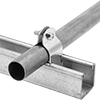Filter by
Material
Shape
Base Thickness
Performance
Yield Strength
Specifications Met
DFARS Specialty Metals
Raw Materials
Building and Machinery Hardware
Material Handling
Facility and Grounds Maintenance
Fabricating and Machining
Electrical
Fastening and Joining
Containers, Storage, and Furniture
Fluid Handling

















































































































